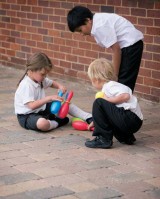Learning through Landscapes explains how children can take the lead...
It is easy to spot the teacher who is committed to art, or the school which has a strong emphasis on music – it becomes woven into the fabric of the learning and the positive messages portrayed to the children are clear and motivating. The same is true for outdoor learning. A school that has a positive approach to outdoor learning provides a stream of messages to its adults and children that learning outdoors is vital and valued.
Research both in the UK and internationally has found that pupils feel they learn better outdoors because:
• outdoor lessons are generally more interesting, varied and relaxed;
• practical lessons are easier to understand;
• teachers are friendlier outdoors.
Initially, the prospect of rethinking your outdoor space can seem like a daunting task. However, with a good understanding of a few basic principles, the development process can be organised into our clear stages designed to help you make the most of your grounds. Since pupil participation is vital to a successful grounds project, building these stages into your teaching can provide your staff team with an understanding of how your grounds are used and valued and a clear idea of the scale of changes needed to make best use of the space.
 At this stage, you need to build a good knowledge of the existing layout and features of your grounds. How they are maintained, and how they are currently used, and valued, by all who use them? What physical features are present in the school grounds now? What activities take place in the grounds before school, during break and lunchtimes and after school? How do people feel about the grounds?
At this stage, you need to build a good knowledge of the existing layout and features of your grounds. How they are maintained, and how they are currently used, and valued, by all who use them? What physical features are present in the school grounds now? What activities take place in the grounds before school, during break and lunchtimes and after school? How do people feel about the grounds?
A large site plan is always useful for gathering information about the grounds, so involve map work as part of the project to support geography learning. Many children can struggle to make the link between paper and reality, so make it easier by creating an illustrated version, with photos of the main areas to help navigation. Ask older children to draw maps of the grounds from memory. You could provide buildings-only plans for them to add features to if a blank canvas is too challenging. Once you have created an accurate map, compare it with the memory maps to see what has been forgotten or exaggerated. This can highlight what is not important to children or what areas they really like or dislike.
Here is your opportunity to develop a shared vision of what you want to do in your outside space. It’s also the school’s chance to clarify what image it wants to convey. Positive messages that can be conveyed by school grounds include: we are proud of our pupils; our school is a welcoming place to be; our school is a desirable place to work; we promote healthy lifestyles.
It is important to ask pupils what they want to be able to do in the grounds and not what would they like to have, as this prompts a physical and emotional response rather than a wish-list of impractical features. Take the opportunity to get children writing creatively about their experiences of their grounds now, and how they would like to use them in the future.
Discussion based activities are also valuable as a learning opportunity and to help pupils value other points of view. Set up two circles of chairs with children sitting in pairs facing each other. Ask the group a question and give two minutes for the outer circle to tell the inner circle what they think, and then swap roles. To make sure everyone was listening, you can then rotate the outer circle, and now each pair has to tell their partner what their previous partner said!
 Now you’ve an idea of potential changes to the use of your grounds, continue to involve children in coming up with possible solutions to the issues that have arisen. Problemsolving workshops are a great way to get pupils and adults working together to explore the difficulties the school has identified and generate creative solutions. Choose one issue and display pairs of photographs, or captions illustrating the situation as it is now and how everyone would like it to be. Get small groups to discuss the issue and ‘fill the gap’ by identifying the steps that would help to achieve what is represented in the improved picture. As well as discussing solutions, children can be involved in design in a variety of different ways. Design work could involve:
Now you’ve an idea of potential changes to the use of your grounds, continue to involve children in coming up with possible solutions to the issues that have arisen. Problemsolving workshops are a great way to get pupils and adults working together to explore the difficulties the school has identified and generate creative solutions. Choose one issue and display pairs of photographs, or captions illustrating the situation as it is now and how everyone would like it to be. Get small groups to discuss the issue and ‘fill the gap’ by identifying the steps that would help to achieve what is represented in the improved picture. As well as discussing solutions, children can be involved in design in a variety of different ways. Design work could involve:
• Drawing
• Modelling
• ICT – as well as specialist design software that the school may already use, garden design software is cheaply available, and might be more userfriendly
• Life-size modelling – many children will find it difficult to mentally scale-up from plans to reality, so recreating plans full scale outdoors – for example, using chairs, PE equipment or other items to represent proposed changes to the grounds – can help.
It’s tempting to plan physical change to your grounds for holiday periods but there are plenty of learning and development opportunities to be had by involving the pupils. The children will also have far more respect for the features that are created if they’ve had a hand in their creation. For example, if you’re planning to have some seating areas installed, pupils could work with an artist or crafts-person to design and construct something unique to the school, class or year group. You may choose to link with art and design, design and technology and ICT to develop signposts for the new spaces. Working with an artist, pupils could design and create sculptures or murals. Working together is an important part of a child’s personal development, so any project that promotes team work is of benefit, whether planting trees, painting a fence or creating a sculpture.
Learning through Landscapes provides advice on all aspects of the use, design and management of school grounds. Visit ltl.org.uk or call 01962 845811 to find out more.
Surveying the site provides many other learning opportunities too - think of all the things that can be measured in the grounds! Depending on the age and ability of the children, this could range from practising the simple use of a tape measure to estimating heights of features through mathematical techniques.
Biodiversity surveys will help ensure that valuable habitats are not accidentally damaged during development. Develop fieldwork skills by using quadrats to count plant species, or setting pitfall traps in different locations to count mini-beasts.
As an art activity, put up a large piece of paper on which a group of pupils can draw their ideas about what they would like to be able to do in their school grounds. Alternatively, pupils could work individually and then put their pictures together to form a collage.
If your marking doesn’t affect pupil progress - stop it!
Ace-Classroom-Support
The side effects of teaching music
Ace-Music
